EFFECTS OF EDDY VISCOSITY ON TIME CORRELATIONS IN LARGE EDDY SIMULATION
DYNAMICAL SYSTEMS, STABILITY, AND CHAOS

In this expository and resources chapter we review selected aspects of the mathematics of dynamical systems, stability, and chaos, within a historical framework that draws together two threads of its early development: celestial mechanics and control theory, and focussing on qualitative theory. From this perspective we show how concepts of stability enable us to classify dynamical equations and their solutions and connect the key issues of nonlinearity, bifurcation, control, and uncertainty that are common to time-dependent problems in natural and engineered systems. We discuss stability and bifurcations in three simple model problems, and conclude with a survey of recent extensions of stability theory to complex networks.
a The
Greek word for governor is kubernetes, from which the mathematician Norbert Wiener (1894–1964) coined the term cybernetics as a name for the collective field of automated control and information theory.
常用流体力学单词
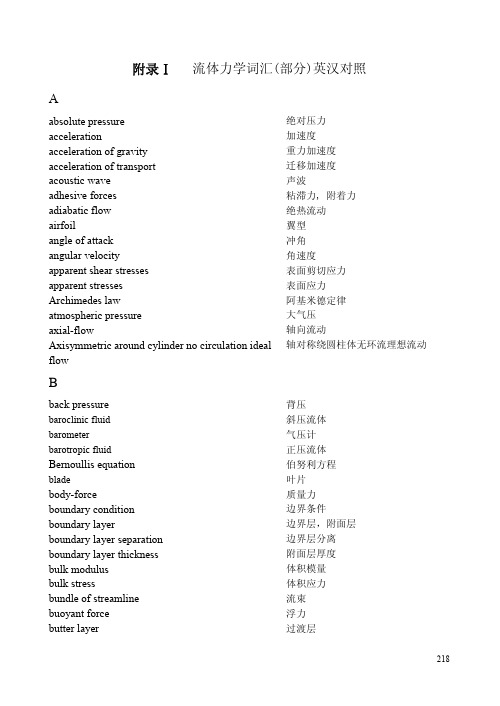
221
incompressible fluid
inertial coordinate system initial condition input intensity of turbulence
interface internal energy internal friction
inviscid fluid
I
脉动应力 流体 流体动力学 流场 流体机械 流体力学 流体质点 流体静力学 自由表面 摩擦系数 摩擦阻力 无粘性流体
气体常数 气体动力学 表压力 几何压力 几何相似 渐缩 渐扩
调和函数 压头损失 传热 亥姆霍兹方程 非均质流体 均质流体 水平力 水平线 水力直径 紊流光滑管区 流体静力学 流体静压力 流体静应力 高超音速流动 (m>5)
背压 斜压流体 气压计 正压流体 伯努利方程 叶片 质量力 边界条件 边界层,附面层 边界层分离 附面层厚度 体积模量 体积应力 流束 浮力 过渡层
218
C
Cauchy-Reimam condition
center of pressure coefficient coefficient of compressibility coefficient of eddy viscosity coefficient of viscosity cohesive forces combined boundary layer completely rough zone of turbulent pipe flow component velocity compressibility compressible fluid conservation equation of energy conservation equation of mass conservation of mechanical energy conservation of moment of momentum conservation of momentum continuity continuum continuum hypothesis control surface control volume convective acceleration convergent-divergent nozzle converging nozzle correction coefficient critical pressure critical Reynolds number critical speed of sound critical state cross section curvature radius curved shock cylindrical coordinate system
青少年特发性脊柱侧弯患者足部姿势和步态特征的3D形态分析及生物力学评价

5294|中国组织工程研究|第25卷|第33期|2021年11月青少年特发性脊柱侧弯患者足部姿势和步态特征的3D 形态分析及生物力学评价朱飞龙1,张 明1,2,吴 宇1, 王 斌1 ,郭晓琦2 ,曹建刚1,2,朱 茜2,3,陈 伟1,2文题释义:青少年特发性脊柱侧弯:是指青少年生长发育快速阶段出现的脊柱不明原因畸形,发病率高达2%-4%,常见于10-18岁的青少年,患者常常表现为脊柱的三维畸形、姿势不对称、椎体及胸廓变形等,严重降低患者的日常生活质量。
步态分析:根据生物力学原理,应用摄像设备、测力板及体表肌电图等技术,在人体步行过程中,客观、定量地反映人体步态特征。
摘要背景:目前对青少年特发性脊柱侧弯患者步行表现的研究,缺少不同严重程度群体的对比,同时忽略了足部姿势对行走的影响。
目的:比较轻、中和重度青少年特发性脊柱侧弯患者与健康同龄人在足部姿势和步行表现的差异,为未来青少年特发性脊柱侧弯行为功能评估和康复治疗提供科学依据。
方法:纳入研究对象共96例,包括64例青少年特发性脊柱侧弯患者和32例健康青少年志愿者,青少年特发性脊柱侧弯患者根据Cobb 角大小细分为轻、中和重度3个级别,其中轻度18例、中度32例及重度14例。
由1名有着丰富经验的物理治疗师按照足姿指数标准来评估受试者足部姿势,采用3D 足部形态学分析扫描仪进行足部扫描并提取足部形态参数,并用GaitScan 仪器进行步态及足底压力数据采集。
将轻、中和重度青少年特发性脊柱侧弯患者与同龄健康青少年进行比较分析,总结其足部姿势、平衡、步态及足底压力分布特征。
结果与结论:①足形态和姿势方面,中和重度青少年特发性脊柱侧弯组足弓指数、重度青少年特发性脊柱侧弯组足姿指数明显高于健康组(P < 0.05);②步态参数方面,重度青少年特发性脊柱侧弯组相对于健康组承重反应期提前,站立末期延迟(P < 0.05),中和重度青少年特发性脊柱侧弯组行走速度较健康组减慢且足底压力中心漂移指数显著增加(P < 0.05);③足底压力分布方面,中和重度青少年特发性脊柱侧弯组内侧、外侧足跟的压力百分比分别显著高于和低于健康组(P < 0.05);重度青少年特发性脊柱侧弯组第一跖骨压力百分比显著高于健康组,而第三、四和五跖骨压力百分比显著低于健康组(P < 0.05);④静态平衡方面,重度青少年特发性脊柱侧弯患者前足的负荷比显著小于后足,左足的负荷比显著小于右足(P < 0.05);⑤结果证实,中至重度青少年特发性脊柱侧弯患者步行效率及平衡稳定性显著下降。
[NASA美国太空总署资料(长期更新)].Turbulence.Model.Predictions.of-NASA-aiaa-99-0157
![[NASA美国太空总署资料(长期更新)].Turbulence.Model.Predictions.of-NASA-aiaa-99-0157](https://img.taocdn.com/s3/m/7791f8bd960590c69ec376b9.png)
37th Aerospace Sciences Meeting & Exhibit January 11-14, 1999/Reno, NV
For permission to copy or republish, contact the American Institute of Aeronautics and Astronautics 1801 Alexander Bell Drive, Suite 500, Reston, VA 20191-4344
AIAA-99-0157
TURBULENCE MODEL PREDICTIONS OF EXTRA-STRAIN RATE EFFECTS IN STRONGLY-CURVED FLOWS
Christopher L. Rumsey and Thomas B. Gatskiy NASA Langley Research Center Hampton, Virginia Joseph H. Morrisonz Analytical Services & Materials, Inc. Hampton, Virginia
The abilities of three types of turbulence models to accurately predict the e ects of curvature on ow in a U-duct are studied. An explicit algebraic stress model performs better than one- or two-equation linear eddy viscosity models, although it is necessary to fully account for the variation of the production-todissipation-rate ratio in the algebraic stress model formulation. None of the turbulence models fully captures the suppressed turbulence near the convex wall or enhanced turbulence near the concave wall. However, a full Reynolds stress model predicts the suppressed turbulence near the convex wall. Some of the underlying assumptions used in the development of algebraic stress models are investigated and compared with the computed ow eld from a full Reynolds stress model. Through this analysis, the assumption of Reynolds stress anisotropy equilibrium used in the algebraic stress model formulation is found to be suspect in regions of strong curvature. Many ow elds being calculated by computational uid dynamics CFD codes are so complex that it can be di cult to determine the source of error in comparison with experiment. For example, the ow over a multi-element airfoil contains a wide variety of challenging physical processes, including
工程流体力学中英翻译

脉动应力
fluid
流体
fluid dynamics
流体动力学
fluid field
流场
fluid machinery
流体机械
fluid mechanics
流体力学
fluid particle
流体质点
fluid statics
流体静力学
free surface
自由表面
比热比
real fluid
粘性流体
real gas
真实气体,实际气体
rectangular coordinate system
直角坐标系
reduced Navier-Stokes equation
简化纳维—斯托克斯方程
Reynoldsnumber
雷诺数
adiabatic flow
绝热流动
airfoil
翼型
angle of attack
冲角
angular velocity
角速度
apparent shear stresses
表面剪切应力
apparent stresses
表面应力
Archimedes law
阿基米德定律
atmospheric pressure
临界雷诺数
critical speed of sound
临界声速
critical state
临界状态
cross section
横截面
curvature radius
曲率半径
curved shock
曲面波
cylindrical coordinate system
柱坐标系
阻力专业词汇
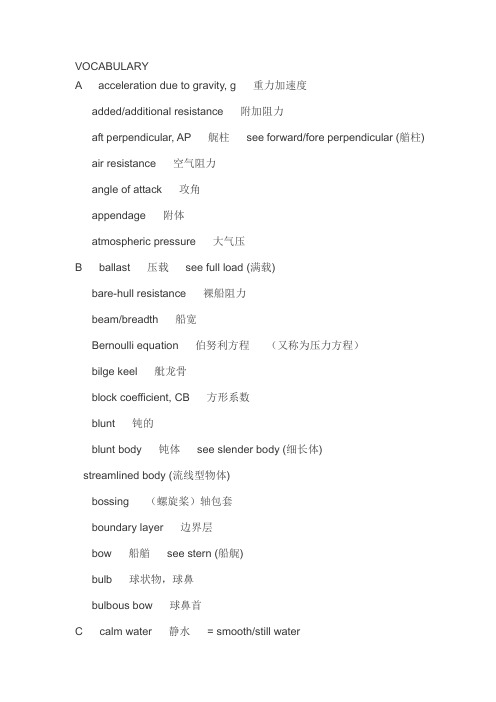
VOCABULARYA acceleration due to gravity, g 重力加速度added/additional resistance 附加阻力aft perpendicular, AP 艉柱see forward/fore perpendicular (艏柱) air resistance 空气阻力angle of attack 攻角appendage 附体atmospheric pressure 大气压B ballast 压载see full load (满载)bare-hull resistance 裸船阻力beam/breadth 船宽Bernoulli equation 伯努利方程(又称为压力方程)bilge keel 舭龙骨block coefficient, CB 方形系数blunt 钝的blunt body 钝体see slender body (细长体)streamlined body (流线型物体)bossing (螺旋桨)轴包套boundary layer 边界层bow 船艏see stern (船艉)bulb 球状物,球鼻bulbous bow 球鼻首C calm water 静水= smooth/still watersee rough seas (波涛汹涌的海上)carriage 拖车= towing carriagecirculating water channel 循环水槽、水筒component 分量、组成部分correlation allowance (船模-实船)换算补贴correlation factor (船模-实船)换算因子corrosion 腐蚀crest 波峰= peak, see trough (波谷)cruiser 巡洋舰cruiser stern 巡洋舰尾see transom stern (方尾)curve of cross-sectional areas 横截面面积曲线= sectional area curveD deadweight 总载重、静负载deep water 深水see shallow water (浅水)depth 水深= water depthdimension 量纲、因次、维dimensional analysis 量纲分析dimensionless 无因次的= nondimensionaldimensions 主尺度= principal dimensionsdisplacement 排水(体积、量)displacement ship 排水型船舶see planing craft (滑行艇)displacement volume 排水体积displacement weight 排水量divergent wave 散波see transverse wave (横波)draft/draught 吃水drag 阻力= resistance, see lift (升力)drift angle 漂角= yawed angledynamic viscosity coefficient, μ动力粘性系数see kinematic viscosity coefficient (运动粘性系数)dynamometer 测力仪E eddy 旋涡eddy resistance 旋涡阻力component of the form resistanceeffective power, PE 有效功率empirical formula 经验公式entrance 进流段see run (去流段), parallel body (平行中体)equivalent plank 相当平板estimation 估算experiment 试验、实验= testextrapolation 外插、外插值see interpolation (内插、内插值)F fine 瘦的(船体)see full (丰满的)forward/fore perpendicular, FP 艏柱see aft perpendicular (艉柱) form factor 形状因子form resistance 形状阻力fouling 污底free surface 自由面(水面)free surface elevation 自由面升高、波高fresh water 淡水see salt water (海水)friction 摩擦= skin frictionfrictional resistance 摩擦阻力Froude’s Law of Comparison傅汝德比较律Froude number, Fn 傅汝德数full 丰满的(船体)see fine (瘦的)full load 满载see ballast (压载)fullness 丰满度full-scale trial 实船试验= trialG geometrically similar bodies 几何相似的物体see mechanical similitude (力学相似)gravity 重力H half angle of entrance (on the load waterline) (载荷水线上的)半进水角heel angle 横倾角hollow 凹陷(谷)see hump (凸起(峰))hull 船体hull form 船型= ship formhump 凸起(峰)see hollow (凹陷(谷))hydrodynamic 水动力的hydrodynamic force 水动力hydrodynamics 水动力学I incompressible 不可压缩的interference effects (兴波)干扰效应interpolation 内插、内插值see extrapolation (外插、外插值) inviscid 无粘性的= nonviscous, see viscousirrotational flow 无旋流、势流= potential flowJK kinematic viscosity coefficient, ν运动粘性系数see dynamic viscosity coefficient (动力粘性系数)knot (kn) 节(速度单位)1节= 1海里/小时 1 knot = 1.852km/h = 0.5144m/secL laminar flow 层流see turbulent flow (湍流、紊流) lift 升力= lift force, see drag (阻力)lift force 升力= liftlinear 线性的see nonlinear (非线性的)linear scale ratio, λ = LS/LM缩尺比longitudinal 纵向的see transverse (横向的)M mass density, ρ质量密度mechanics 力学mechanical similitude 力学相似see geometrically similar bodies (几何相似的物体)merchant ship 商船see warship, combatant ship (军舰)midship section 中船横剖面model 船模= ship modelmodel basin 船池= towing tankmodel test/experiment 船模试验N naval architect 造船师naval architecture 造船Newton, N 牛顿(力的单位) 1 N = 1 kg•m/sec2,kN (千牛顿) nondimensional 无因次的= dimensionlessnonlinear 非线性的see linear (线性的)nonviscous 无粘性的= inviscid, see viscous (粘性的)numerical towing tank 数值船池OP parallel body 平行中体see entrance (入流段), run (去流段) parent form 母型parent ship 母型船performance (水动力)性能planing craft 滑行艇see displacement ship(排水型船舶)plank 厚板、平板= platepotential flow 势流、无旋流= irrotational flowsee viscous flow (粘性流)power 功率pressure 压力pressure distribution 压力分布principal dimensions 主尺度= dimensionsprismatic coefficient, CP 棱形系数propeller/screw 螺旋桨proportion 尺度比propulsion test 推进试验propulsive efficiency 推进效率QR residuary/residual resistance 剩余阻力resistance 阻力= dragresistance test/experiment 阻力试验Reynolds number, Rn 雷诺数roughness 粗糙度rough seas 波涛汹涌的海上see calm water (静水)rudder 舵run 去流段see entrance (入流段), parallel body (平行中体) S salt water 海水see fresh water (淡水)scale effect 尺度效应section area 横截面面积self-propelled model 自航模self-propulsion experiment/test 自航试验separation (流动)分离service speed 服务航速shaft bracket (螺旋桨)轴支架shallow water 浅水see deep water (深水)ship form 船型= hull formshoulder 进流段或去流段和平行中体的接合部(肩部)similitude 相似、相似性see mechanical similitude (力学相似) singularity 奇点(包括源、汇、偶极、涡)singularity distribution 奇点分布sink 汇see source (源)sinkage 下沉see trim (纵倾)slender body 细长体see blunt body (钝体)slenderness 细长度smooth/still water 静水= calm watersee rough seas (波涛汹涌的海上)source 源see sink (汇)spray resistance/drag 喷溅阻力stem 船头stern 船艉see bow (船艏)stimulation (湍流)激流streamlined 流线型的streamlined body 流线型物体see blunt body (钝体)submerged body 潜体superstructure (船的)上层建筑surface ship 水面船T test 试验= experimenttotal resistance 总阻力towing carriage 拖车= carriagetowing tank 拖曳水池、船池= model basintransom stern 方尾see cruiser stern (巡洋舰尾)transverse 横向的see longitudinal (纵向的)transverse wave 横波see divergent wave (散波)trial (实船)试验= full-scale trialtrim 纵倾see sinkage (下沉)trim angle 纵倾角trip wire 激流丝see stimulation (激流)trough 波谷see crest (波峰)turbulent flow 湍流、紊流see laminar flow (层流)UV velocity 速度(流速)velocity distribution 速度(流速)分布velocity potential 速度势viscosity 粘性viscous 粘性的see inviscid/nonviscous (无粘性的)viscous flow 粘性流see potential/irrotational flow (势流)viscous force 粘性力viscous pressure resistance 粘压阻力component of the form resistanceviscous resistance 粘性阻力W wake 伴流wake fraction 伴流分数see thrust-deduction fraction (推力减额分数)warship 军舰= combatant shipsee merchant ship (商船)waterline 水线waterplane 水线面water tunnel 水槽、水筒Watt, W 瓦(功率单位) 1 W = 1 N•m/sec,kW (千瓦)wave 波浪、海浪wave-breaking resistance 碎波阻力wave-making resistance 兴波阻力wave pattern 波型wetted surface (船体)湿表面wind tunnel 风洞XY yawed angle 首摇角、漂角= drift angleZABBREVIATIONATTC American Towing Tank Conference 美国船池会议BMT British Maritime Technology 英国海事技术研究所CFD Computational Fluid Dynamics 计算流体动力学DTMB David Taylor Model Basin 美国戴维泰勒船池DTRC David Taylor Research Center 美国戴维泰勒研究中心EFD Experimental Fluid Dynamics 实验流体动力学ITTC International Towing Tank Conference 国际船池会议LCB longitudinal center of buoyancy= longitudinal position of the center of buoyancy 浮心纵向位置LCG longitudinal center of gravity= longitudinal position of the center of gravity 重心纵向位置LWL load-waterline 载荷水线MARIN Maritime Research Institute 荷兰海事研究所NPL National Physical Laboratory 英国国家物理实验室SNAME The Society of Naval Architects and Marine Engineers 美国造船及轮机工程师协会。
湍流模型

Favre平均
f = rf/ r + f’ = f + f’ with f’ = rf’/ r =0
湍流封闭问题
时间平均N-S 方程
mb=2/3m, dij Kronecker函数 delta (dij =1 for i=j and dij = 0 for i=j)
时间N-S方程
对于稳态、2维边界层流动:
Kolmogorov理论
较大尺寸的漩涡从主流吸取运动能量; 大尺度的漩涡运动能传递到较小尺度的漩涡中; 大尺度漩涡通过瀑布过程将运动能传递到小尺 度漩涡中; 对于尺寸非常小的漩涡, 摩擦力 (粘性应力) 变 得非常大, 运动能转化 (耗散) 成为内能.
Kolmogorov 简历 (网上摘录)
湍流尺度
大尺度漩涡的能量损失正比例于 l/u, 定义式 为: e =O(u2/(l/u) =O(u3/l)
湍流能量分布
½ u’iu’i = ∫0E(k)dk
分解瞬时变量
U = U + u” P = P + p”
原因: o 我们关心平均值,而不是瞬态值. o 非实际的精细网格求解所有尺度的湍流及 高分辨率
RNG k-e model
(a) 模型常量从k-e 模型中得到不同值; 并且 (b) the dissipation-rate transport equation includes an additional source term per unit volume: Se = - rae2/k where a = Cm 3 (1- / 0)/(1+b 3 ), 0 = 4.38, and b = 0.012. = S*k/e where S2 = 2 SijSij and Sij = 0.5 * (dUi/dXj + dUj/dXi) The additional source term becomes significant for flows with large strain rates, i.e. when >> 0. The parameter is a measure of the ratio of the turbulent to mean time scale. In the limit of weak strain where S and tends to zero, the additional source term tends to zero and the original form of the k-e model is recovered.
湍流模型PPT课件
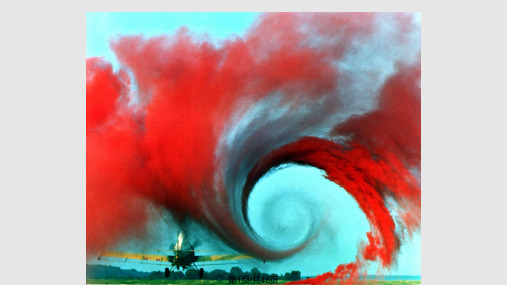
RNG k-e model
(a) 模型常量从k-e 模型中得到不同值; 并且
(b) the dissipation-rate transport equation includes an additional source term per unit volume:
Se = - rae2/k
where
第27页/共48页
Wall function
• Main assumptions
oVariations in velocity etc. are predominantly normal to the wall, leading to onedimensional behaviour.
oEffects of pressure gradients and body forces are negligibly small, leading to uniform shear stress in the layer.
第25页/共48页
Wall boundary conditions
• Two-layer model and Low Reynolds number model • The Log-Law wall function
第26页/共48页
Two-layer model
• NWL (Near Wall Layer) requires >15 grids which should be specified • Y+ ~ 3 • The switching criterion depends on the low-Reynolds number model
标准k-e模型 •湍流模型常量
第21页/共48页
粘弹性力学研究

粘弹性力学研究一、引言粘弹性力学是研究物质在受到外力作用下表现出的黏弹性特性的学科,广泛应用于材料科学、工程力学和生物医学等领域。
本文旨在探讨粘弹性力学的研究进展和应用。
二、粘弹性力学的概念和特性1. 粘弹性的定义粘弹性是指物质在受力作用下既具有粘性(viscosity)又具有弹性(elasticity)的特性。
粘性使物质能够保持形变,而弹性使其具有恢复原状的能力。
2. 粘弹性的特点(1)时效性:物质的粘弹性特性会随着时间的推移而发生变化。
物质在受力作用下会逐渐产生应力松弛或应变积累。
(2)非线性:粘弹性行为通常不服从线性规律,而是具有复杂的非线性响应。
(3)温度敏感性:温度变化会显著影响物质的粘弹性特性,不同温度下的物质表现出不同的粘弹性行为。
三、粘弹性力学的数学模型1. 麦克弗森模型麦克弗森模型是最简单的粘弹性模型之一,将物质的粘弹性行为描述为阻尼器和弹簧并联的复合系统。
该模型可以用来解释线性粘弹性物质的行为。
2. 邓科-楞茨模型邓科-楞茨模型是一种常见的粘弹性模型,它通过引入多个弹簧和阻尼器的并联组合,更好地描述了非线性粘弹性物质的行为。
该模型可以用于解释生物软组织等复杂材料的粘弹性行为。
四、粘弹性力学的应用1. 材料科学领域粘弹性力学在材料科学的研究中起到了重要作用。
通过研究材料的粘弹性特性,可以设计出更具韧性和耐久性的材料,提高材料的应变容限和抗疲劳性能。
2. 工程力学领域在工程力学中,粘弹性力学被广泛应用于结构和材料的设计与分析。
例如,在土木工程领域,研究土壤的粘弹性特性有助于更准确地预测土壤的变形和承载能力。
3. 生物医学领域粘弹性力学在生物医学领域的应用越来越受到关注。
通过研究生物组织的粘弹性特性,可以为疾病的早期诊断和治疗提供重要依据。
例如,通过测量肿瘤组织的粘弹性特性,可以评估肿瘤的恶性程度和治疗效果。
五、总结粘弹性力学是一门研究物质粘性和弹性相互作用的学科,其概念和模型为材料科学、工程力学和生物医学等领域的研究和应用提供了基础。
Oscillation of nonlinear dynamic equations on time scales

Oscillation of nonlinear dynamicequations on time scalesS.H.Saker 1Faculty of Mathematics and Computer Science,Adam Mickiewicz University,Matejki 48/49,60-769Poznan,PolandAbstractBy means of Riccati transformation techniques,we establish some new oscillation criteria for the second order nonlinear dynamic equationðp ðt Þx D ðt ÞÞD þq ðt Þf ðx ðr ðt ÞÞÞ¼0;t 2½a ;b ;on time scales in terms of the coefficients and the graininess function.We illustrate our results with a nontrivial example.Ó2002Elsevier Inc.All rights reserved.Keywords:Oscillation;Second order dynamic equations;Time scale;Riccati transformation technique1.IntroductionThe theory of time scales,which has recently received a lot of attention,was introduced by Stefan Hilger in his Ph.D.Thesis in 1988in order to unify continuous and discrete analysis (see [10]).Not only can this theory of the so-called ‘‘dynamic equations’’unify the theories of differential equations and difference equations,but also extends these classical cases to cases ‘‘in bet-ween’’,e.g.,to the so-called q -difference equations.E-mail addresses:shsaker@.pl,shsaker@mum.mans.eun.eg (S.H.Saker).1Present address:Department of Mathematics,Faculty of Science,Mansoura University,Mansoura,35516,Egypt.0096-3003/$-see front matter Ó2002Elsevier Inc.All rights reserved.doi:10.1016/S0096-3003(02)00829-9Applied Mathematics and Computation 148(2004)81–9182S.H.Saker/put.148(2004)81–91A time scale T is an arbitrary closed subset of the reals,and the cases when this time scale is equal to the reals or to the integers represent the classical theories of differential and of difference equations.Many other interesting time scales exist,and they give rise to plenty of applications,among them the study of population dynamic models which are discrete in season(and may follow a difference scheme with variable step-size or often modeled by continuous dynamic systems),die out,say in winter,while their eggs are incubating or dormant,and then in season again,hatching gives rise to a nonoverlapping population(see[4]).Since Stefen Hilger formed the definition of derivatives and integrals on time scales,several authors has expounded on various aspects of the new theory,see the paper by Agarwal et al.[1]and the references cited therein.A book on the subject of time scale,i.e.,measure chain,by Bohner and Peterson[2]summarizes and organizes much of time scale calculus.For the notions used below we refer to the next section about calculus on time scale and references given therein.In recent years there has been much research activity concerning the oscil-lation and nonoscillation of solutions of some different equations on time scales,we refer the reader to the few papers[3–9].In[4],the authors considered the second order dynamic equation ðpðtÞx DðtÞÞDþqðtÞxðrðtÞÞ¼0;t2½a;band given necessary and sufficient condition for oscillation of all solution on unbounded time scales.Unfortunately,the oscillation criteria are unsatisfac-tory since additional assumptions have to be imposed on the unknown solu-tions.In[6],the authors considered the same equation and supposed that pðtÞis bounded above on½t0;1Þ,t02T,h0¼inf f lðtÞ:t2½t0;1Þg>0,and have used the Riccati equation and proved that ifZ1qðtÞD t¼1t0then every solution is oscillatory in½t0;1Þ.It is clear that the results given in[6],can not be applied when pðtÞis unbounded,lðtÞ¼0and qðtÞ¼tÀa whena>1.Following this trend,to develop the qualitative theory of dynamic equations on time scales,in this paper we shall consider the following nonlinear second order dynamic equationðpðtÞx DðtÞÞDþqðtÞfðxðrðtÞÞÞ¼0;t2½a;b ;ð1:1Þwhere p and q are positive,real-valued rd-continuous functions defined on the time scales interval[a,b](throughout a;b2T with a>b)such thatZ1 aD tpðtÞ¼1;ð1:2ÞZ1 aD tpðtÞ<1;ð1:3Þf:R!R such that xfðxÞ>0and fðxÞP Kx for x¼0:ð1:4ÞBefore doing so,let usfirst recall that a solution of(1.1)is a nontrivial real function xðtÞsatisfying Eq.(1.1)for t P a.A solution xðtÞof(1.1)is said to be oscillatory if it is neither eventually positive nor eventually negative,otherwise it is nonoscillatory.Eq.(1.1)is said to be oscillatory if all its solutions are oscillatory.Our attention is restricted to those solutions of(1.1)which exist on some half line½t x;1Þand satisfy sup fj xðtÞj:t>t0g>0for any t0P t x.In this paper we intend to use the Riccati transformation technique for obtaining several oscillation criteria for(1.1)when(1.2)and(1.3)hold.Our results in this paper improve the results given in[4,6].Applications to equa-tions to which previously known criteria for oscillation are not applicable are given.The paper is organized as follows:In the next Section we present the basic definitions and the theory of calculus on time scales.Section3,devoted to the proof of the sufficient conditions for oscillation of all solutions of Eq.(1.1).2.Some preliminariesA time scale T is an arbitrary nonempty closed subset of the real numbers R. Since we are interested in oscillatory behavior,we suppose that the time scale under consideration is not bounded above,i.e.,it is a time scale interval of the form½a;1Þ.On any time scale we define the forward and backward jump operators byrðtÞ:¼inf f s2T:s>t g and qðtÞ:¼sup f s2T:s<t g:ð2:1ÞA point t2is said to be left-dense if qðtÞ¼t,right-dense if rðtÞ¼t,left-scattered if qðtÞ<t,and right-scattered if rðtÞ>t.The graininess l of the time scale is defined by lðtÞ:¼rðtÞÀt.For a function f:T!R(the range R of f may actually be replaced by any Banach space),the(delta)derivative is defined byf DðtÞ¼lims!t fðrðtÞÞÀfðsÞrðtÞÀs;where s2T n f rðtÞg:ð2:2ÞA function f:½a;b !R is said to be rd-continuous if it is continuous at each right-dense point and if there exists afinite left limit in all left-dense points,and f is said to be differentiable if its derivative exists.The derivative and the shift operator r are related by the formulaS.H.Saker/put.148(2004)81–9183f r ¼f þl f D ;where f r :¼f r :ð2:3ÞLet f be a real-valued function defined on an interval ½a ;b .We say that f is increasing,decreasing,nondecreasing,and nonincreasing on ½a ;b if t 1;t 22½a ;b and t 2>t 1imply f ðt 2Þ>f ðt 1Þ,f ðt 2Þ<f ðt 1Þ,f ðt 2ÞP f ðt 1Þ,and f ðt 2Þ6f ðt 1Þ,respectively.Let f be a differentiable function on ½a ;b .Then f is in-creasing,decreasing,nondecreasing,and nonincreasing on ½a ;b if f D ðt Þ>0,f D ðt Þ<0,f D ðt ÞP 0,and f D ðt Þ60for all t 2½a ;b Þ,respectively.We will make use of the following product and quotient rules for the derivative of the product fg and the quotient f =g of two differentiable func-tions f and gðfg ÞD¼f D ðt Þg ðt Þþf ðr ðt ÞÞg D ðt Þ¼f ðt Þg D ðt Þþf D ðt Þg ðr ðt ÞÞ;f g D ðt Þ¼f D ðt Þg ðt ÞÀf ðt Þg D ðt Þg ðt Þg ðr ðt ÞÞ:ð2:4ÞBy using the product rule,the derivative of f ðt Þ¼ðt Àa Þm for m 2N and a 2T can be calculated asf D ðt Þ¼Xm À1m ¼0ðr ðt ÞÀa Þm ðt Àa Þm Àm À1:For a ;b 2T and a differentiable function f ,the Cauchy integral of f D is defined byZb a f D ðt ÞD t ¼f ðb ÞÀf ða Þ:The integration by parts formula readsZb a f D ðt Þg ðt ÞD t ¼f ðb Þg ðb ÞÀf ða Þg ða ÞÀZ b a f r ðt Þg D ðt ÞD t ð2:5Þand infinite integrals are defined asZ 1a f ðs ÞD s ¼lim t !1Z taf ðs ÞD s :In case T ¼R we haver ðt Þ¼q ðt Þ¼t ;l ðt Þ 0;f D ¼f 0;and Zb a f ðt ÞD t ¼Z b a f ðt Þd t84S.H.Saker /put.148(2004)81–91and in case T¼Z we haverðtÞ¼tþ1;qðtÞ¼tÀ1;lðtÞ 1;f D¼D f;andZ b a fðtÞD t¼X bÀ1t¼afðtÞ:3.Main resultsIn this section we give some new oscillation criteria for Eq.(1.1).Since we are interested in oscillatory behavior we will suppose that the time scale T under consideration is not bounded above,i.e.,it is a time scale interval of the form½a;1Þ.Theorem3.1.Assume that(1.2)and(1.4)hold.Furthermore,assume that there exists a positive function dðtÞsuch that for every positive constant M,lim supt!1Z tajdðrðsÞÞqðsÞ"Àðd DðsÞÞ2pðsÞðsþM lðsÞÞ4s dðrðsÞÞ#D s¼1:ð3:1ÞThen every solution of Eq.(1.1)is oscillatory on½a;1Þ.Proof.Suppose to the contrary that xðtÞis a nonoscillatory solution of(1.1). Without loss of generality,we may assume that xðtÞis an eventually positive solution of(1.1)such that xðtÞ>0for all t P t0>a.We shall consider only this case,since the substitution yðtÞ¼ÀxðtÞtransforms Eq.(1.1)into an equation of the same form.In view of(1.1)we haveðpðtÞx DðtÞÞD¼ÀqðtÞfðxðrðtÞÞÞ<0ð3:2Þfor all t P t0,and so f pðtÞx Dðt g is an eventually decreasing function.Wefirst show that pðtÞðx DðtÞÞf g is eventually nonnegative.Indeed,since qðtÞis a posi-tive function,the decreasing function pðtÞðx DðtÞÞis either eventually positive or eventually negative.Suppose there exists an integer t1P t0such that pðt1Þðx Dðt1ÞÞ¼c<0;then from(3.2)we have pðtÞx DðtÞ<pðt1Þx Dðt1Þ¼c for t P t1,hencex DðtÞ6c1pðtÞwhich implies thatxðtÞ6xðt1ÞþcZ tt11pðsÞD s!À1as t!1ð3:3ÞS.H.Saker/put.148(2004)81–9185which contradicts the fact that xðtÞ>0for all t P t0.Hence pðtÞx DðtÞf g is eventually nonnegative.Therefore,we see that there is some t0such that xðtÞ>0;x DðtÞP0;ðpðtÞx DðtÞÞD<0;t P t0:ð3:4ÞDefine the function wðtÞbywðtÞ¼dðtÞpðtÞðx DðtÞÞxðtÞ;t P t0:ð3:5ÞThen wðtÞ>0and using(2.4)yields thatw DðtÞ¼d DðtÞpðtÞx DðtÞxðtÞþdðrðtÞÞpðtÞx DðtÞxðtÞD:Using the calculus in Section2,we havew DðtÞ¼d DðtÞdðtÞwðtÞþdðrðtÞÞxðtÞpðtÞx DðtÞðÞDÀpðtÞx DðtÞðÞ2xðtÞxðrðtÞÞ!:ð3:6ÞIn view of(1.1),(1.4)and(3.6),we obtainw DðtÞ6ÀjdðrðtÞÞqðtÞþd DðtÞdðtÞwðtÞÀdðrðtÞÞpðtÞx DðtÞðÞ2xðtÞxðrðtÞÞ:ð3:7ÞUsing(2.3)and the definition of wðtÞand(3.7)we havew DðtÞ6ÀjdðrðtÞÞqðtÞþd DðtÞdðtÞwðtÞÀdðrðtÞÞw2ðtÞdðtÞpðtÞ11þlðtÞxðtÞxðtÞ:ð3:8ÞSince x DðtÞis a nonnegative and decreasing function and xðtÞis positive and nondecreasing function,then we have xðtÞP x DðtÞðtÀt0Þand there exists a t1P t0sufficiently large and a positive constant M such that x DðtÞ=xðtÞ6M=t for all t P t1.Substituting in(3.8),we obtainw DðtÞ6ÀjdðrðtÞÞqðtÞþd DðtÞdðtÞwðtÞÀdðrðtÞÞw2ðtÞd2ðtÞpðtÞttþM lðtÞ:ð3:9ÞHence,w DðtÞ6ÀjdðrðtÞÞqðtÞþd DðtÞdðtÞwðtÞÀQðtÞw2ðtÞdðtÞ;ð3:10ÞwhereQðtÞ¼dðrðtÞÞpðtÞttþM lðtÞ:86S.H.Saker/put.148(2004)81–91Thus,(3.10)implies that w D ðt Þ6Àjd ðr ðt ÞÞq ðt Þþðd D ðt ÞÞ24Q ðt ÞÀffiffiffiffiffiffiffiffiffiQ ðt Þp d ðt Þw ðt Þ"Àd D ðt Þ2ffiffiffiffiffiffiffiffiffiQ ðt Þp #2<Àjd ðr ðt ÞÞq ðt Þ"Àðd D ðt ÞÞ24Q ðt Þ#:Then,we have w D ðt Þ<Àjd ðr ðt ÞÞq ðt Þ"Àðd D ðt ÞÞ24Q ðt Þ#:ð3:11ÞIntegrating (3.11)from t 1to t ,we obtain Àw ðt 1Þ<w ðt ÞÀw ðt 1Þ<ÀZ t t 1jd ðr ðs ÞÞq ðs Þ"Àðd D ðs ÞÞ24Q ðs Þ#D s ð3:12Þwhich yields Z t t 1jd ðr ðs ÞÞq ðs Þ"Àðd D ðs ÞÞ24Q ðs Þ#D s <w ðt 1Þfor all large t .This is contrary to (3.1).The proof is complete.ÃFrom Theorem 3.1,we can obtain different conditions for oscillation of all solutions of (1.1)by different choices of d ðt Þ.For instance,let d ðt Þ¼t ,t P t 0.By Theorem 3.1we have the following result.Corollary 3.1.Assume that (1.2)and (1.4)hold.Furthermore,assume that for every positive constant M lim sup t !1Z t ajr ðs Þq ðs Þ Àp ðs Þðs þM l ðs ÞÞ4s r ðs Þ D s ¼1:ð3:13ÞThen,every solution of (1.1)is oscillatory on ½a ;1Þ.Example 3.1.Consider the D -differential Euler equationx DD ðt Þþc t r ðt Þx ðr ðt ÞÞ¼0;t 2½1;1Þ:ð3:14ÞIf T ¼R ,then (3.14)is the second order Euler differential equationx 00ðt Þþc t 2x ðt Þ¼0;t P 1ð3:15Þand then l ðt Þ¼0,r ðt Þ¼t .Therefore Corollary 3.1gives for Eq.(3.15)the following oscillation condition:S.H.Saker /put.148(2004)81–9187Z t a r ðs Þq ðs Þ Àðs þM l ðs ÞÞ4s r ðs Þ D s ¼Z t 1c s s 2h Às 4s 2i d s ¼Z t 14c À1s d s !1as t !1if c >1=4:This is already compatible with the well known oscillatory behavior of (3.15)(see [12]).If T ¼Z ,then (3.14)is the second order discrete Euler difference equationD 2x t þc t ðt þ1Þx t þ1¼0;t ¼1;2;...ð3:16Þand then l ðt Þ¼1;r ðt Þ¼t þ1:Therefore,without loss of generality if M ¼1,Corollary 3.1gives for Eq.(3.16)the following oscillation condition:Z t a r ðs Þq ðs Þ Àðs þM l ðs ÞÞ4s r ðs Þ D s ¼X t À1s ¼ac ðs þ1Þs ðs þ1Þ Às þ14s ðs þ1Þ ¼X t À1s ¼a 4c À1s ÀX t À1s ¼a c s 2!1ð3:17Þas t !1if c >1=4.This is already compatible with the well known oscillatory behavior of (3.16).It is known in [13]that when l 61=4,(3.16)has a nonos-cillatory solution.Hence,Theorem 3.1and Corollary 3.1are sharp.Note that the results in [4,6]cannot be applied to (3.14).Theorem 3.2.Assume that (1.2)and (1.4)hold.Let d ðt Þbe a positive function.If lim sup t !11t m Z t a ðt Às Þm jd ðr ðs ÞÞq ðs Þ"Àðd D ðs ÞÞ2p ðs Þðs þM l ðs ÞÞ4s d ðr ðs ÞÞ#D s ¼1ð3:18Þfor every positive constant M ,and an odd positive integer m ,then every solution of (1.1)oscillates on ½a ;1Þ.Proof.We proceed as in the proof of Theorem 3.1,we may assume that (1.1)has a nonoscillatory solution x ðt Þsuch that x ðt Þ>0,x D ðt ÞP 0,ðp ðt Þx D ðt ÞÞD 60for t P t 1.Define w ðt Þby (3.5)as before,then we have w ðt Þ>0and there is some M >0such that (3.11)holds.Then from (3.11)we have jd ðr ðt ÞÞq ðt Þ"Àðd D ðt ÞÞ2#<Àw D ðt Þ:Therefore,Z t t 1ðt Às Þm jd ðr ðt ÞÞq ðt Þ"Àðd D ðt ÞÞ24Q ðt Þ#D s 6ÀZ t t 1ðt Às Þm w D ðs ÞD s :ð3:19Þ88S.H.Saker /put.148(2004)81–91An integration by parts the right hand side leads toZ t t1ðtÀsÞm w DðsÞD s¼ðtÀsÞm wðsÞj tt1þðÀ1Þmþ1Z tt1X mÀ1m¼0rðtÞðÀsÞmðtÀsÞmÀmÀ1wðrðsÞÞD s:Then from(3.19)we haveZ t t1ðtÀsÞm jdðrðtÞÞqðtÞ"Àðd DðtÞÞ24QðtÞ#D s<ðtÀt1Þm wðt1ÞÀðÀ1Þmþ1Z tt1X mÀ1m¼0rðtÞðÀsÞmðtÀsÞmÀmÀ1wðrðsÞÞD s:Now since m is odd integer,thenZ t t1ðtÀsÞm jdðrðtÞÞqðtÞ"Àðd DðtÞÞ24QðtÞ#D s<ðtÀt1Þm wðt1Þ:Then1 t m Z tt1ðtÀsÞm jdðrðtÞÞqðtÞ"Àðd DðtÞÞ24QðtÞ#D s<tÀt1tmwðt1Þ:Hence,lim supt!11t mZ tt1ðtÀsÞm jdðrðsÞÞqðsÞ"Àðd DðsÞÞ2pðsÞðsþM lðsÞÞ4s dðrðsÞÞ#D s!finite numberwhich is a contradiction with(3.18).The proof is complete.ÃNote that when dðtÞ¼1,the(3.18)reduces tolim supt!11t mZ taðtÀsÞm qðsÞD s¼1;ð3:20Þwhich can be considered as the extension of Kamenev type oscillation criteria for second order differential equations(see[11]).When T¼R,then(3.20)becomeslim supt!11t mZ taðtÀsÞm qðsÞd s¼1ð3:21ÞS.H.Saker/put.148(2004)81–9189and when T¼Z,then(3.20)becomeslim supt!11t mX tÀ1s¼aðtÀsÞm qðsÞ¼1:ð3:22ÞNow,we give some sufficient conditions when(1.3)holds,which guarantee that every solution of Eq.(1.1)oscillates or converges to zero in½a;1Þ. Theorem3.3.Assume that(1.3)and(1.4)hold.Furthermore,assume that there exists a positive function dðtÞsuch that for every positive constant M(3.1)holds, andZ1 a 1Z taqðsÞD s D t¼1:ð3:23ÞThen every solution of Eq.(1.1)is oscillatory or converges to zero on½a;1Þ. Proof.We proceed as in Theorem3.1we assume that Eq.(1.1)has a non-oscillatory solution such that xðtÞxðrðtÞÞ>0,for t P t0>a.(We shall consider only this case,since the substitution yðtÞ¼ÀxðtÞtransforms Eq.(1.1)into an equation of the same form).From the proof of Theorem3.1we see that there exist two possible cases of the sign of x DðtÞ.The proof when x DðtÞis an even-tually positive is similar to that of the proof of Theorem3.1and hence is omitted.Next,suppose that x DðtÞ<0for t P t1.Then xðtÞis decreasing and lim t!1xðtÞ¼b P0.We assert that b¼0.If not,then xðrðtÞÞ>b>0for t P t2>t1.Since fðxÞin nondecreasing there exists t3>t2such that fðxðrðtÞÞÞP fðbÞfor t P t3.Define the functionuðtÞ¼pðtÞx DðtÞ;then from Eq.(1.1)for t P t3,we obtainu DðtÞ¼ÀqðtÞfðxðrðtÞÞÞ6ÀfðbÞqðtÞ:Hence,for t P t3we haveuðtÞ6uðt3ÞÀfðbÞZ tt3qðsÞD s<ÀfðbÞZ tt3qðsÞD s:Since uðt3Þ¼pðt3Þx Dðt3Þ<0.Integrating the last inequality from t3to t we haveZ t t3x DðsÞD s6ÀfðbÞ2Z tt31pðsÞZ st3qðsÞD s D s:90S.H.Saker/put.148(2004)81–91S.H.Saker/put.148(2004)81–9191 By condition(3.23)we get xðtÞ!À1as t!1,and this is a contradiction to the fact that xðtÞ>0for t P t0.Thus b¼0and then xðtÞ!0as t!1.The proof is complete.ÃReferences[1]R.P.Agarwal,M.Bohner,D.OÕRegan,A.Peterson,Dynamic equations on time scales:asurvey,p.Appl.Math.141(2002)1–26.[2]M.Bohner, A.Peterson,Dynamic Equations on Time Scales.An Introduction withApplications,Birkh€a user Boston,Boston,MA,2001.[3]M.Bohner,O.Dosly,W.Kratz,An oscillation theorem for discrete eigenvalue problems,Rocky Mountain J.Math.,in press.[4]O.Dosly,S.Hilger,A necessary and sufficient condition for oscillation of the Sturm Liouvilledynamic equation on time scales,p.Appl.Math.141(2002)147–158.[5]A.Elvan,E.Lynn,A.Peterson,B.Kaymakcßalan,Oscillation results for a dynamic equationon a time scale,J.Differ.Eqs.Appl.7(6)(2001)793–810.[6]L.Erbe,A.Peterson,Riccati equations on a measure chain,Dynamic systems and applications3(Atlanta,GA,1999),Dynamic,Atlanta,GA,2001,pp.193–199.[7]L.Erbe,A.Peterson,Positive solutions for a nonlinear differential equation on a measurechain.Boundary value problems and related topics,put.Modell.32(2000)571–585.[8]L.Erbe,A.Peterson,Oscillation criteria for second-order matrix dynamic equations on a timescale,p.Appl.Math.141(2002)169–185.[9]G.S.Guseinov,B.Kaymakcßalan,On a disconjugacy criterion for second order dynamicequations on time scales,p.Appl.Math.141(2002)187–196.[10]S.Hilger,Analysis on measure chains––a unified approach to continuous and discrete calculus,Results Math.18(1990)18–56.[11]I.V.Kamenev,Integral criterion for oscillation of linear differential equations of second order,Math.Zemetki(1978)249–251.[12]H.J.Li,Oscillation criteria for second order linear differential equations,J.Math.Anal.Appl.194(1995)312–321.[13]G.Zhang,S.S.Cheng,A necessary and sufficient oscillation condition for the discrete Eulerequation,Pan American Math.J.9(1999)29–34.。
船舶与海洋工程论文中英文资料外文翻译文献

中英文资料外文翻译文献A Simple Prediction Formula of Roll Damping of Conventional Cargo Ships on the Basis of lkeda's Method and Its LimitationSince the roll damping of ships has significant effects of viscosity, it is difficult to calculate it theoretically. Therefore, experimental results or some prediction methods are used to get the roll damping in design stage of ships. Among some prediction methods, Ikeda’s one is widely used in many ship motion computer programs. Using the method, the roll damping of various ship hulls with various bilge keels can be calculated to investigate its characteristics. To calculate the roil damping of each ship, detailed data of the ship are needed to input. Therefore, a simpler prediction method is expected in primary design stage. Such a simple method must be useful to validate the results obtained by a computer code to predict it on the basis of Ikeda,s method, too. On the basis of the predicted roll damping by Ikeda’s method for various ships, a very simple prediction formula of the roll damping of ships is deduced in the present paper. Ship hull forms are systematically changed by changing length, beam, draft, mid-ship sectional coefficient and prismatic coefficient. It is found, however, that this simple formula can not be used for ships that have high position of the center of gravity. A modified method to improve accuracy for such ships is proposed.Key words: Roll damping, simple prediction formula, wave component, eddy component, bilge keel component.IntroductionIn 1970s, strip methods for predicting ship motions in 5-degree of freedoms in waves have been established. The methods are based on potential flow theories (Ursell-Tasai method, source distribution method and so on), and can predict pitch, heave, sway and yaw motions of ships in waves in fairly good accuracy. In roll motion, however, the strip methods do not work well because of significant viscous effects on the roll damping. Therefore, some empirical formulas or experimental dataare used to predict the roll damping in the strip methods.To improve the prediction of roll motions by these strip methods, one of the authors carried out a research project to develop a roll damping prediction method which has the same concept and the same order of accuracy as the strip methods which are based on hydrodynamic forces acting on strips. The review of the prediction method was made by Himeno [5] and Ikeda [6,7] with the computer program.The prediction method, which is now called Ikeda’s method, divides the roll damping into the frictional (BF), the wave (Bw),the eddy (Be) and the bilge keel (Bbk) components at zero forward speed, and at forward speed, the lift (Bi) is added. Increases of wave and friction components due to advance speed are also corrected on the basis of experimental results. Then the roll damping coefficient B44 (= roll damping moment (kgfm)/roll angular velocity (rad/sec)) can be expressed as follows: B44 B bk (1)At zero forward speed, each component except the friction and lift components are predicted for each cross section with unit length and the predicted values are summed up along the ship length. The friction component is predicted by Kato’s formula for a three-dimensional ship shape. Modification functions for predicting the forward speed effects on the roll damping components are developed for the friction, wave and eddy components. The computer program of the method was published, and the method has been widely used.For these 30 years, the original Ikeda’s method developed for conven tional cargo ships has been improved to apply many kinds of ships, for examples, more slender and round ships, fishing boats, barges, ships with skegs and so on. The original method is also widely used. However, sometimes, different conclusions of roll mot ions were derived even though the same Ikeda’s method was used in the calculations. Then, to check the accuracy of the computer programs of the same Ikeda’s method, a more simple prediction method with the almost same accuracy as the Ikeda’s original one h as been expected to be developed. It is said that in design stages of ships, Ikeda’s method is too complicated to use. To meet these needs, a simple roll damping prediction method was deduced by using regression analysis [8].Previous Prediction FormulaThe simple prediction formula proposed in previous paper can not be used for modem ships that have high position of center of gravity or long natural roll period such as large passenger ships with relatively flat hull shape. In order to investigate its limitation, the authors compared the result of this prediction method with original Ikeda’s one while out of its calculating limitation. Fig. 1 shows the result of the comparison with their method of roll damping. The upper one is on the condition that the center of gravity is low and the lower one on the condition that the center of gravity is high.From this figure, the roll damping estimated by this prediction formula is in good agreement with the roll damping calculated by the Ikeda’s method for low positi on of center of gravity, but the error margin grows for the high position of center of gravity. The results suggest that the previous prediction formula is necessary to be revised. Methodical Series ShipsModified prediction formula will be developed on the basis of the predicted results by Ikeda’s method using the methodical series ships. This series ships are constructed based on the Taylor Standard Series and its hull shapes are methodically changed by changing length, beam, draft, midship sectional coefficient and longitudinal prismatic coefficient. The geometries of the series ships are given by the following equations. Proposal of New Prediction Method of Roll DampingIn this chapter, the characteristics of each component of the roll damping, the frictional, the wave, the eddy and the bilge keel components at zero advanced speed, are discussed, and a simple prediction formula of each component is developed.As well known, the wave component of the roll damping for a two-dimensional cross section can be calculated by potential flow theories in fairly good accuracy. In Ikeda's method, the wave damping of a strip section is not calculated and the calculated values by any potential flow theories are used as the wave damping.reason why viscous effects are significant in only roll damping can be explained as follows. Fig. 4 shows the wave component of the roll damping for 2-D sections calculated by a potential flow theory.ConclusionsA simple prediction method of the roll damping of ships is developed on the basis of the Ikeda’s original prediction method which was developed in the same concept as a strip method for calculating ship motions in waves. Using the data of a ship, B/d, Cb,Cm, OG/d, G),bBK/B, Ibk/Lpp,(pa, the roll damping of a ship can be approx imately predicted. Moreover, the limit of application of Ikeda’s prediction method to modern ships that have buttock flow stern is demonstrated by the model experiment. The computer program of the method can be downloaded from the Home Page of Ikeda’s Labo (AcknowledgmentsThis work was supported by the Grant-in Aid for Scientific Research of the Japan Society for Promotion of Science (No. 18360415).The authors wish to express sincere appreciation to Prof. N. Umeda of Osaka University for valuable suggestions to this study.References五、Y. Ikeda, Y. Himeno, N. Tanaka, On roll damping force of shipEffects of friction of hull and normal force of bilge keels, Journal of the Kansai Society of Naval Architects 161 (1976) 41-49. (in Japanese)六、Y. Ikeda, K. Komatsu, Y. Himeno, N. Tanaka, On roll damping force of ship~Effects of hull surface pressure created by bilge keels, Journal of the Kansai Society of Naval Architects 165 (1977) 31-40. (in Japanese)七、Y. Ikeda, Y. Himeno, N. Tanaka, On eddy making component of roll damping force on naked hull, Journal of the Society of Naval Architects 142 (1977) 59-69. (in Japanese)八、Y. Ikeda, Y. Himeno, N. Tanaka, Components of roll damping of ship at forward speed, Journal of the Society of Naval Architects 143 (1978) 121-133. (in Japanese) 九、Y. Himeno, Prediction of Ship Roll Damping一State of the Art, Report of Department of Naval Architecture & Marine Engineering, University of Michigan, No.239, 1981.十、Y. Ikeda, Prediction Method of Roll Damping, Report of Department of Naval Architecture, University of Osaka Prefecture, 1982.十一、Y. Ikeda, Roll damping, in: Proceedings of 1stSymposium of Marine Dynamics Research Group, Japan, 1984, pp. 241-250. (in Japanese)十二、Y. Kawahara, Characteristics of roll damping of various ship types and as imple prediction formula of roll damping on the basis of Ikeda’s method, in: Proceedings of the 4th Asia-Pacific Workshop on Marine Hydrodymics, Taipei, China, 2008,pp. 79-86.十三、Y. Ikeda, T. Fujiwara, Y. Himeno, N. Tanaka, Velocity field around ship hull in roll motion, Journal of the Kansai Society of Naval Architects 171 (1978) 33-45. (in Japanese)十四、N. Tanaka, Y. Himeno, Y. Ikeda, K. Isomura,Experimental study on bilge keel effect for shallow draftship, Journal of the Kansai Society of Naval Architects 180 (1981) 69-75. (in Japanese)常规货船的横摇阻尼在池田方法基础上的一个简单预测方法及其局限性摘要:由于船的横摇阻尼对其粘度有显着的影响,所以很难在理论上计算。
viscosity的名词解释

viscosity的名词解释黏度(Viscosity)是指流体内部抵抗流动的能力,或者说是流体的阻力。
黏度是衡量液体流动性质的一个重要物理特性,它与流体内分子的相互间作用力有关。
黏度的概念最早由德国科学家R. Hooke于17世纪提出,并得到了牛顿的广泛研究和解释。
1. 黏度的定义与单位黏度表示的是流体流动时遇到的阻力。
当施加外力使流体流动时,黏度决定了流体内部分子间的摩擦阻力大小。
黏度的单位是帕斯卡·秒(Pa·s),在工程学中经常使用更常见的单位,如厘泊(cP,1 cP = 0.001 Pa·s)。
2. 黏度与温度关系黏度与温度之间存在着密切的关系。
一般来说,随着温度的升高,液体的黏度会减小,而气体的黏度则会增加。
这是因为温度的变化会影响流体分子的动力学行为。
在液体中,温度升高会使分子的动能增加,分子间相互作用力减弱,从而减小液体的黏度。
而在气体中,温度升高则会增加气体分子的热运动,增大气体分子之间的碰撞频率和动力,从而增加气体的黏度。
3. 黏度与流体类型不同类型的流体具有不同的黏度特性。
牛顿流体是最简单的流体类型,其黏度与应力成正比。
牛顿流体的黏度是常数,不受应力或剪切速率的影响。
常见的牛顿流体包括水和其他许多溶液。
另一种类型是非牛顿流体,其黏度会随着应力的增加而变化,即黏度与剪切速率相关。
非牛顿流体包括许多复杂的流体,如胶体、泡沫和血液等。
4. 测量黏度的方法黏度的测量在科学和工程领域中具有广泛的应用。
常见的测量黏度的方法包括旋转式黏度计、落球式黏度计和圆盘式黏度计等。
这些仪器通过施加外力并测量流体的流动速度或阻力来确定黏度的大小。
测量黏度对于许多领域都非常重要,如石油工业、食品和制药等。
黏度是流体力学中一个重要的概念,对于了解流体行为和设计工程系统具有重要意义。
通过对液体和气体的黏度进行实验研究和定量测量,我们可以更好地理解流体的流动特性,并应用于各种实际应用中。
The Study of Diffusion and Osmosis
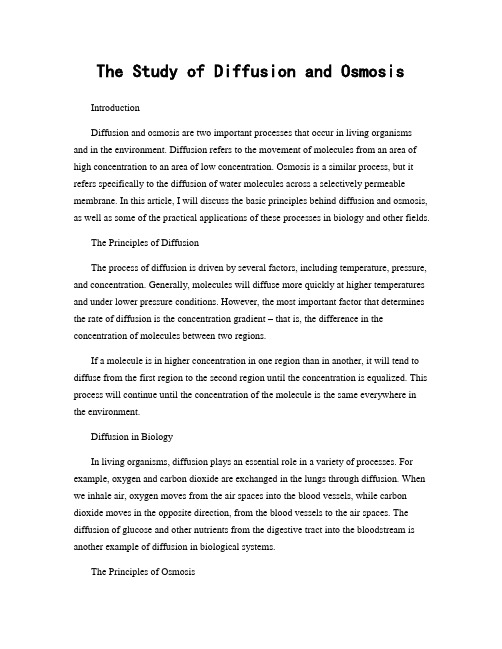
The Study of Diffusion and OsmosisIntroductionDiffusion and osmosis are two important processes that occur in living organisms and in the environment. Diffusion refers to the movement of molecules from an area of high concentration to an area of low concentration. Osmosis is a similar process, but it refers specifically to the diffusion of water molecules across a selectively permeable membrane. In this article, I will discuss the basic principles behind diffusion and osmosis, as well as some of the practical applications of these processes in biology and other fields.The Principles of DiffusionThe process of diffusion is driven by several factors, including temperature, pressure, and concentration. Generally, molecules will diffuse more quickly at higher temperatures and under lower pressure conditions. However, the most important factor that determines the rate of diffusion is the concentration gradient – that is, the difference in the concentration of molecules between two regions.If a molecule is in higher concentration in one region than in another, it will tend to diffuse from the first region to the second region until the concentration is equalized. This process will continue until the concentration of the molecule is the same everywhere in the environment.Diffusion in BiologyIn living organisms, diffusion plays an essential role in a variety of processes. For example, oxygen and carbon dioxide are exchanged in the lungs through diffusion. When we inhale air, oxygen moves from the air spaces into the blood vessels, while carbon dioxide moves in the opposite direction, from the blood vessels to the air spaces. The diffusion of glucose and other nutrients from the digestive tract into the bloodstream is another example of diffusion in biological systems.The Principles of OsmosisOsmosis is a specific type of diffusion that involves the movement of water molecules across a selectively permeable membrane. A selectively permeable membrane is one that only allows certain molecules to pass through. In the case of osmosis, water can move freely across the membrane, while other molecules cannot.When a selectively permeable membrane separates two solutions with different concentrations of solutes, the process of osmosis will occur. Water molecules will move from the region of lower solute concentration to the region of higher solute concentration, in an attempt to equalize the solute concentration on both sides of the membrane.Osmosis in BiologyOsmosis plays an important role in biology, particularly in the uptake of water by plant cells. Plant cells are surrounded by a rigid cell wall, which prevents them from bursting when water enters the cell. However, the cell wall is permeable to water molecules, which allows water to enter the cell through osmosis.Osmosis can also play a role in the regulation of blood pressure in humans. When the concentration of solutes in the blood increases, the osmotic pressure increases as well. This can cause water to move out of the blood vessels and into the surrounding tissues, which can lead to a decrease in blood pressure.Applications of Diffusion and OsmosisThe principles of diffusion and osmosis have practical applications in a variety of fields, including medicine, manufacturing, and agriculture. In medicine, understanding the principles of diffusion and osmosis can help doctors to develop more effective drug delivery systems.In manufacturing, membranes with selective permeability can be used to separate different types of molecules in a variety of chemical processes. For example, reverse osmosis is a process that involves separating salt and other impurities from seawater to produce fresh water.In agriculture, osmosis is used to maintain plants' turgor pressure, which keeps the plant rigid and upright. Osmosis is also used in the preservation of food, such as by dehydrating fruits and vegetables to prevent spoilage.ConclusionDiffusion and osmosis are two fundamental concepts in biology and have practical applications in a variety of fields. Understanding these processes can help us to better understand the world around us and to develop new technologies and solutions to problems. By continuing to study these processes, we can unlock new insights into the mysteries of life and the natural world.。
[整理版]给水排水工程专业英语词汇
![[整理版]给水排水工程专业英语词汇](https://img.taocdn.com/s3/m/235001200a4c2e3f5727a5e9856a561252d32137.png)
brsion磨损brsive研磨剂、研磨的ccelerted grvity settling加速重力沉降cclimtiztion驯化、环境适应性cidic酸的、酸性的、cidiy使酸化、变酸cidogenic引起酸化的ctivted crbon活性炭ctivted sludge process活性污泥工艺dhesion附着力、胶粘dsorbte被吸附物dsorbent吸附剂dsorption吸附dsorption isotherm吸附等温线dvnced oxidtion高级氧化dvnced oxidtion process(OPs)高级氧化工艺dvnced tretment高级处理dvection水平对流erted lgoon曝气塘erobic好氧的、需氧的inity亲和力ter-cooler二次冷却器、后冷却器gr琼脂ggregtion聚合、集合体ging衰老、老化ir diuser气体扩散器ir lit气升泵ir stripping空气吹脱、气提lcohol distilltion酒精蒸馏lg 藻类、海藻lginte藻酸盐lignment定线、对准、成直线lkline碱性的lklinity 碱度llowble geometric suction hed o the pump安装高度 llowble vcuumetric hed允许真空高度lum明矾luminte铝酸盐luminosilicte硅酸铝luminum sulte 硫酸铝mino cid氨基酸 mino sugr氨基糖mmoni氨、氨水mmonium铵mino氨基的nion阴离子nerobic厌氧的nerobic digestion厌氧消化noxic缺氧的ntcid中和酸性的、抗酸性nthrcite无烟煤ntibiotics抗生素、抗生学perture 孔、孔径、缝隙pplince器具用具pproch velocity行近流速ppurtennces附属设备quclude不透水层qutic水生的qutic lor水生植物区系queduct输水管quier含水层rchimeden阿基米德的rid干旱的、贫瘠的romtic芳族的、芬芳的rsenic砷rtesin自流井sbestos cement石棉水泥sh pit灰坑ssy化验ssimilte吸收、同化tomic bsorption spectrophotometry原子吸收分光谱测量tomizer喷雾器ttrition磨耗、磨损uger pump螺旋泵uthorise批准utotrophic自养的uxiliry辅助的bcksiphonge倒虹吸bckwshing反冲洗bcteri细菌bcterium细菌bcteriologicl 细菌学的bcteriophge噬菌体bllst整流器bllsted locculent settling加重絮凝沉淀ble挡板bllsting gent加重剂brrier屏障、潜堰brium钡brometric 大气压力的bseline基线bsic基本的、碱性的btch rector序批式反应器、间歇式反应器belt ilter带式滤机bench-scle小型的(台架规模)benzene ring 苯环bicrbonte重碳酸盐bidet坐浴盆、净身盆bind凝固BOD(biochemicl oxygen demnd)生化需氧量biodegrdble生物可降解的bioilter生物滤池biologicl tretment生物处理biomss(单位面积或体积内)生物量biopolymer 生物聚合物biostimulnt生物刺激物质biotowers塔式生物滤池biotoxicity 生物毒性bisulite亚硫酸氢盐blsturnce slg高炉灰渣boiler锅炉、汽锅blst urnce(鼓风)炉block nd tckle滑轮(组)bonding压焊、粘合、连接boosting 增压bore汽缸筒、钻孔、孔bound wter结合水brckish咸味的brek cistern 中间水箱brekpoint chlorintion折点加氯brewery酿酒厂、啤酒厂brine盐水Brownin motion布朗运动bucket桶buering cpcity缓冲能力building block 构件、结构单元bulk density堆积密度、松密度bulking sludge膨胀污泥butyric cid丁酸bypss旁通管byproduct副产品cdmium镉clcium钙clcium crbonte碳酸钙clcium crbonte precipitte碳酸钙沉淀物cnl导管、槽、沟渠cpillry毛细管、毛细作用cpitl投资crbohydrte 碳水化合物、糖类crbon碳CO2(Crbon dioxide)二氧化碳crbonceous碳质的、含碳的crbonte碳酸盐crboniztion干馏、碳化(物)crboxyl羧基crboxylic 羧基的crcinogenic致癌物的csing泵壳cst iron铸铁、生铁ctlyst催化剂ctlytic converter催化转换器ctch bsin集水池、截流井、雨水口ctenry悬链线ction阳离子ctionic-exchnge resin阳离子交换树脂custic sod苛性钠cell inclusion细胞内含物cellulose纤维素cellulose cette醋酸纤维素cement水泥centrl heting集中供暖centriugtion离心法、离心分离centriuge 离心分离机cess pool污水坑、粪坑chbzite菱沸石chin链条chnnel流道、渠道、河床chnneliztion管【渠】道化chrge neutrliztion电中和check vlve 止回阀、单向阀、逆止阀chemicl oxidtion化学氧化COD(chemicl oxygen demnd)化学需氧量chemicl precipittion化学沉淀chemicl scrubber化学洗涤塔chlormine氯胺chloride氯化物chlorinted hydrocrbon氯化烃chloroorm氯仿chloro-orgnic compound氯化有机化合物chloropltinte氯铂酸盐chromte 铬酸盐chromtogrphy层析、色谱(法)chromium铬chronic toxicity慢性毒性chute斜管、滑槽cistern水塔、蓄水池cly黏土、泥土clinoptilolite斜发沸石cloud o ions电子云corse screen粗格栅cogulnt混凝剂colesce凝聚、聚结coblt钴、钴类颜料cocurrent下向流cogwheel齿轮coil线团、卷曲coliorm bcteri大肠型细菌coliphge大肠杆菌噬菌体collecting sewer污水支管collide碰撞colloidl胶体的、胶质的colony菌落column settling test 沉降柱试验combined sewer合流制下水道comminutor粉碎机(污水预处理)compctor压缩器、夯具compct lyer压缩层comprtmentliztion区分、分格化complete-mix完全混合式complex络合物、配合物、复合体composing堆制肥料composite合成的、复合的composition合成物、成分compost堆肥、混合肥料composted sludge堆肥compression coupling压紧联轴节compression settling压缩沉淀concentrte集中、浓缩concentrtion浓缩、浓度concentrtion dierences浓度差concentrtion polriztion浓差极化condenstion冷凝作用、凝结作用condenser冷凝器conduit管道、沟渠、喷泉、导管conined quier承压含水层constituent构分、成分contctor接触器contminnt污染物、致污物contrctor承包人、订约人conventionl ertion传统曝气(指传统活性污泥法)convection current对流、运流conveyor传送机、运输机coordintion compound配位化合物copper铜corrosive腐蚀性的、腐蚀剂corrugtion波纹、起皱coupling联结、联轴器coulombic库仑定律的countercurrent上向流counterion补偿离子、带相反电荷的离子covlent bond 共价键crcking破裂、裂crne起重机crockery陶器、瓦器化cross-low横向流cross section横截面crush压碎、碾碎cryptosporidium prvum小隐孢子虫cultivte培养cumultive percent累计百分数cupbord橱cupronickel白铜、铜镍合金cutwy剖面图cyst胞、包囊、膀胱dlton道尔顿(质量单位)deerte脱气debris悬浮泥沙decnt滗水decnter滗析器decy腐朽、衰减decying vegettion腐殖质decomposition分解、腐烂degresing脱脂(法)、除油(法)deleterious有毒的、有害的denitriiction 反硝化作用deplete耗尽derivtive衍生物、导数、派生词deslintion除盐作用dessicnt干燥剂destbilize脱稳detention time停留时间deteriorte恶化detrimentl有害的digrmmtic图表的、概略的dil刻度盘、转盘dilysis渗析diphrgm隔膜dirrhe腹泻dichromte重铬酸盐diuse lyer扩散层diuser分散器diusion扩散、传播diusivity扩散率、扩散能力digestion消化【作用】、老化digestor消化池dimethylnitrosmine二甲基亚硝胺dipole双极子、偶极dischrge流量、排除、排放discourge阻碍discrete prticle settling离散颗粒沉降disinection消毒dislodge移动、清除、取出dispersion扩散、弥散(现象)disposl处理、处置dissocite分离、游离dissocition溶解、分解、离解DO(dissolved oxygen)溶解氧distilltion蒸馏、蒸馏法、蒸馏物distillery蒸馏间、酿酒厂divlent二价的divinybenzene二乙烯苯domestic wstewter(sewer)生活废水、家庭污水donor供体、原料物质dosge剂量、配药、用量dosing定量给料drg coeicient阻力系数dringe ditch排水沟dringe pump排水泵drwdown水位降低drw o排除(水)、撤退drw-o tp放水龙头drughtproo不透风的dry wether low枯季流量dul wter systems双水道系统dump倾倒、垃圾堆dyestu染料ecologicl生态学的、社会生态学的eddy漩涡edible oil食用油eluent流出的、废水、污水、排水渠ejector(jet pump)射流泵electrode电极、焊条electrodilysis(ED)电渗析electrokinetic电动的、动电学的electrolyte 电解质、电解液electrosttic orce静电力electrotherml电热的elevted tnk 高位水池、高架水箱ellipsoid椭圆体em bbr(electromotive orce)电动势encse封闭、嵌入end product终产物endogenous respirtion内源呼吸energetics热力学、动能学enterovirus肠道病毒entrp截留enzyme酶equivlent rction当量份数Escherichi coli大肠埃希氏菌eutrophiction富营养化作用evcute疏散、排泄evportion蒸发(作用)evpotrnspirtion土壤水分蒸发蒸腾损失总量exclusion排除、去除excrement排泄物、大便exiltrtion漏出、渗出extended ertion延时曝气extrct提炼、萃取extrction 萃取bric建筑物、构造ecl排泄物的eces粪屎eedlot饲育场erment酵素、发酵ermenttion发酵erric三价铁、含铁的errous亚铁的、含铁的iberglss玻璃纤维iberglss reinorced plstic玻璃纤维强化塑料ilmentous bcteri丝状菌ilter滤池蝇iltrte过滤、筛选、滤出液iltrtion过滤ine screen细格栅ixed growth system固定式生长系统lnged joint法兰连接lexibility弹性、适应性lotble可浮起的loc絮体locculnt絮凝剂loccultion絮凝lottion thickener气浮浓缩luctution波动、起伏luy松散的luid bed流化床lume水槽、斜槽、水道luoride氟化物lux通量orce min压力干管orced ventiltion 强制通风ormzin福尔马肼oul污秽的、淤塞的ouling污垢rctionte使分馏ree hydroxyl rdicl自由羟基reon氟利昂riction摩擦(力)ullwy vlve全开阀ungi真菌类urnce炉子、熔炉glvnic电流的glvnized电镀的、镀锌的grnet石榴石、深红色gs chromtogrphy 气相色谱gsket垫圈gstroenteritis肠胃炎gstrointestinl trct胃肠道ger 齿轮、传动装置、换挡、调整gel凝胶体genertion产生、【世】代genetic遗传的、起源的germicidl有杀菌力的geomembrne土工膜、隔泥网膜glnd填料盖、密封装置glss reinorced polyester玻璃纤维增强聚酯GRP:glss reinorcedplstic玻璃钢grdient梯度、坡度、倾斜的grduted cylinder量筒grin颗粒、细粒grnite花岗岩grnulr粒状的grnulr ctivted crbon(GC)粒状活性炭grnule 颗粒、细粒grting栅栏grvel砂砾grvity thickener重力浓缩池grese油脂grind磨碎grinder研磨机grit粗砂grit chmber沉砂池groundwter地下水gullet水槽、水落管、海峡hil冰雹、致敬hl rection potentil半反应电势hndril栏杆、扶手hsten加速、促进hedloss水头损失heting coil加热盘管、加热旋管helminth 寄生虫heptitis肝炎hermeticlly密封地heterotroph异养生物heterotrophic异养的hindered settling拥挤沉淀hinge铰链hoist起重机hollow iber membrne 中空纤维膜hook吊钩hopper加料斗hormone荷尔蒙、激素hose水龙带、软管humidity湿气、湿度hycinth水葫芦hydrted lime熟石灰、氢氧化钙hydrulic 水力学hydrogen氢hydrogen bstrction rection夺氢反应hydrogen bonding 氢键结合hydrogen ion ctivity氢离子活性(度)hydrogen peroxide(H2O2)过氧化氢hydrogen sulide硫化氢hydrologic水文的hydrology水文学、水文地理学hydrolysis水解hydrolyzed metl ions水解金属离子hydrogeologicl 水文地质的hydrophobic:wter-hting hydrophilic:wter-lovinghydroxyl hydrosttic静水力学的hydrosttic pressure 静水压力hydroxide氢氧化物、羟化物hydroxide氢氧化镁hydroxyptite羟磷灰石hydroxyl羟基、氢氧基hygro —【词头】湿、液体hygroscopic moisture吸湿水hypochlorite次氯盐酸hypochlorous cid次氯酸immiscible不能混合的、不能溶混的immunodeiciency免疫缺陷impeller叶轮impervious不透水的、不渗透的、密封的impurity杂质、混杂物inctivte灭活incident入射光incinerte焚烧incinertion焚烧incinertor焚化炉inclined plte settler斜板沉淀器inclined tube settler斜管沉淀器indictor 指示剂inducded velocity诱导速度inductively诱导地inert惰性的inertil 惯性的inertil orces惯性力inectious易传染的iniltrtion渗透inrstructure下部构造inhibitory抑制的inoculte接种、嫁接insulted隔热的、绝缘的intke pipe吸水管、取水管intke pump取水泵intensity强度、强烈itertive迭代的、重复的interception拦截、截留interceptor截砂阱interceptor sewer截流管道、污水(管)截砂阱intermedite hydrolysis中间水解interstitil空隙的、形成空隙的intestinl trct肠道intrusion闯入iodine number碘值iodo-(构词成分)碘ion离子ion exchnge离子交换ioniztion离子化、电离ion-selective membrne离子选择性膜irreversibility 不可逆性irrigtion灌溉、冲洗irritnt刺激物isoelectric point等点电isomorphous replcement同晶置换jellylike胶体状的kinemtic运动学的kinemtic viscosity动力黏性lg滞后、用隔热材料保护lgoon污水塘lminr层流的lndill垃圾填埋lndill lechte填埋沥滤液lndscpe wtering景观水lnthnum镧ltent het潜热lterl 支管线、侧部lttice structure晶格结构lvtory厕所、洗脸盆、浴室lying 布置、敷设、瞄准lyout规划、设计、布局图lechte沥出液、沥滤液led铅legionell军团菌lid盖子、顶、罩lignd配位体、配合基lignin木质素liner interpoltion线性内插法liner衬垫、衬里locl resistnce局部阻力lysis溶胞、溶菌mcertor切碎机、浸渍器mcroloccultion同向絮凝mcromolecule大分子、高分子mgnesium monel蒙乃尔铜-镍合金min总干管、电网、电源mkeup wter补充水mlodorous有恶臭的mngnese锰mnhole检查井、检修孔mnure肥mrsh湿地、沼泽地mss curve累积曲线mss spectrometry质谱测量、质谱分析料mtrix基体、基质metpcking肉类加工业mechnism机理membrne膜、隔膜membrne biorector膜生物反应器membrne iltrtion膜滤mercptn硫醇mercury汞、水银mesh网孔、网丝mesophilic嗜温的、中温的metbolism新陈代谢、变形metl plting nd inishing金属电镀与表面精整meteorologicl气象(学)的methne 沼气methnogenesis甲烷生成methnogenic bcteri产甲烷菌methnol甲醇micelle胶态离子、微团、胶囊microbil growth微生物增长microiltrtion微滤microloccultion异向絮凝microorgnism微生物micropore微孔microscreen 微筛millimpere毫安培mine dringe矿山排水mishndling违规操作MLSS:mixed-liquor suspended solids混合液悬浮固体浓度MLVSS:mixed-liquor voltile suspended solids混合液挥发性悬浮固体浓度module基本单位、模数molr extinction coeicient摩尔消光系数moleculr weight cuto截留分子量molybdte钼酸盐monomer单体monoril hoist单轨吊车monovlent单价的mortr 砂浆、胶泥multiple herth多炉膛multiple herth incinerte多段焚烧炉multiply繁殖、增加multistge lsh evportion多级闪蒸mutgenic诱变的nnoiltrtion(N)纳滤nephelometric浊度计的Nernst potentil能斯脱电位neutrlize使中和、压制nickel镍nitrte硝酸盐nitriiction硝化作用nitrogen 氮nitrogenous含氮的nitron氮NDM(n-nitrosodimethylmine)N-亚硝基二甲胺nocrdi诺卡式菌属、土壤丝菌属nomenclture术语、命名法noninectious 无传染性的nonionizing不电离的nonpoint source非点源nonpotble use非饮用的利用NRV:non-return vlve单向阀、止回阀nonvoltile非挥发性的normlity 标准状态、当量浓度noxious有毒的nozzle管口、喷嘴nutrient有营养的oblte扁平的、扁圆的observtion well观测井odor气味o pek额定的、正常的、非峰值的oset支管、乙字管olction嗅觉olctory嗅觉的oocyst卵囊opque 不透明物、不传热的operble pump工作泵operting regime工作(操作)体制orgnism生物体、有机体orthokinetic loccultion同向絮凝(作用)orthophosphte正磷酸盐osmotic渗透性的osmotic pressure渗透压outge停机、停电outll排水口、河口ov:ovum的复数,卵子overlow溢流overlow rte 溢流率overlnd low地表径流oxidtion氧化oxidtion ditch system氧化沟系统oxidtion-reduction rection氧化还原反应oxide氧化物oxidizing gent 氧化剂oxygen氧ozone臭氧prllel br平行棒prent compound母体化合物prshll巴歇尔氏测流量装置prticulte微粒、颗粒pthogen病原体pthogenic致病的、病原的PCB多氯联苯peikinetic loccultion异向絮凝(作用)perceptible显而易见的、可察觉的perchloroethylene全氯乙烯perorted plte 多孔板perormed预制成的、预成型的化氢periodic tble(元素)周期表permngnte高锰酸盐permebility渗透性permemeter渗透仪permselectivity选择透过性permetion渗入、透过perspective view透视图perturbtion混乱、小扰动peroxyl(hydrogenperoxide)过氧petri dish培养皿piesteri piscicid幽灵藻phrmceuticl医药品phenolic酚的、石碳酸的phosphte磷酸盐phosphorus磷photolysis光分解、光解作用photometer光度计phretic surce浅层地下水面phyto-【词头】植物phytometer植物剂piezometer压力计、压强计pilot-plnt中试厂pipeline 管道(线)piping gllery管廊piston活塞pit坑pivot枢轴、支点plnt植物、车间、设备、培养plque斑点plsm等离子体、原生质、血浆plstic luid塑性流体plte nd rme板框式plting电镀pleted crtridge ilter折叠滤芯过滤器plug-low柱塞流plumbo solvency溶铅力plunger潜水者、活塞plunger pump 活塞泵pneumtic气压的、气动的、装满空气的point source点源polrity极性polriztion极化(作用)、偏振(现象)poliomyelitis小儿麻痹症poliovirus 脊髓灰质炎病毒polishing process精处理法polluntnt污染物质polyluminum chloride聚合氯化铝polymide聚酰胺polyelectrolyte聚合(高分子)电解质polyester聚酯polyiron chloride聚合氯化铁polymeric聚合的、聚合体的polymeriztion聚合polyphosphte聚磷酸盐polypropylene聚丙烯polystyrene 聚苯乙烯polyvinyl聚乙烯化合物polyvinyl chloride聚氯乙烯ponding积水、蓄水porosity孔隙率port端口、入口positive-displcement-type pump容积式泵potssium钾potentil determining ions决定电位离子powdered ctivted crbon(PC)粉末活性炭prechlorintion预加氯precipitte沉淀物、沉淀precipittion沉淀(作用)、沉积物、降水(量)prehydrolized预水解的preliminry tretment预处理premises房产、房屋、前提、前言pressure pipe 压水管primry tretment初级处理probbility概率、可能性procretion生产、生殖PLC:Progrm Logic Control程序逻辑控制prolte扁长的prolierte增生扩散propeller pump螺旋泵、轴流泵property器材、财产、物品、性质propionic cid丙酸protein蛋白质proton质子protozon原生动物pulp nd pper纸浆与造纸pump drin pit积水坑、排水坑putrescent将腐烂的、腐败的putrescible 易腐烂的putrescibility易腐烂pyrolysis高温分解quicklime生石灰quiescent静止的rditor散热器、辐射体rgged粗糙的ril hoist桥式吊车rinll雨量、降雨rke 耙子rm活塞rech河段regent试剂receptcle容器recess凹槽reclmtion驯化、回收、改良red het赤热状态redox氧化还原作用reduce stte还原态reduced mteril还原性物质reducing gent还原剂rerctory难降解的、难熔的rerigernt 制冷剂、制冷的reuse废物、垃圾、拒绝regenernt再生剂regenertion再生regulte调节、控制reinorce-concrete钢筋混凝土renovte更新、修复repulsive orce排斥力reserve pump备用泵residue残留物、剩余物restbitiztion再稳定restornt恢复剂retentte(在渗析过程中未能通过半透膜而被保留的)截留物、滞留物retention time停留时间retort蒸器、曲颈瓶reverse osmosis反渗透Reynolds number雷诺数rim边、轮缘rinse漂洗、冲洗rotor叶轮、转子runo径流(量)、流量、流出rupture破裂slinity含盐量、咸度、盐浓度smpling port取样口snitry公共厕所snitry sewer生活污水管道snitry wste生活废水sturtion饱和度scle盐垢scling缩放比例sctter分散、散开scttered离散的、分散的scttered light散射光scvengerscrew螺丝钉、螺孔、螺旋桨scourin洗涤、冲刷screenings筛渣、筛余物screw pump螺旋(杆)泵清洗剂、净化剂scum浮渣、铁渣、泡沫seling压实填料secondry tretment二级处理sedimenttion沉淀、沉降seep渗出、渗漏selenium硒sel-priming自吸semirid半干旱的semiconductor半导体semipermeble membrne半透膜sensory感官的、感觉的seprte sewer分流制下水道sequencing bth rector(SBR)序批式反应器settling column沉降柱sewer污水管sewerge排水工程sewerge system排水系统、排水工程storm sewer雨水管strter启动器(钮)strtum地层stormwter collection line暴雨收集管线speciied(技术规范中)规定的speci ic yield单位水产量sleet雨夹雪supericil表面的subterrnen地下的surce wter地表水sink洗涤盆、污水池、接收器simulte模拟swmplnd沼泽地sloppy湿透的、液体的、水多的suluric cid硫酸stbilize稳定sulur硫sodium钠sludge沉泥、淤泥synthesis合成、综合sodium nitrte硝酸钠sterile无菌的suction抽气、吸入subctchment子流域subsurce表面下的、地下的SI units国际标准单位sprocket链轮stringy纤维的 slide滑动、幻灯片sluice水闸、泄水管、水力冲泄swirl涡状形 sump污水坑、集水池silt淤泥、泥沙、煤粉、残渣sticky黏性的 slipping plne滑动面 surce chrge表面电荷side rection副反应synthetic orgnic polymer合成有机聚合物surce-ctive gent表面活性剂synthetic detergent合成清洁剂structurl imperection结构性缺陷solid line实线Shultz-Hrdy rule苏采—哈代原则strch淀粉slurry泥浆、浆 sweep loc扫沉絮体、沉淀型絮体speciic grvity 比重surce loding表面负荷solids lux固体通量stry分散的、杂散的 subside下沉、沉淀 subsidence curve沉降曲线sieve nlysis 筛分析strining筛滤、隔滤striner滤网、过滤器spent用尽、失去效能的sorption吸着【作用】stgnnt停滞的supericil velocity 表观速度、空塔速度shock lod冲击负荷stndrd potentil标准电势sulide硫化物swell膨胀、增大styrene苯乙烯scle-up按比例增加、扩大 septicity腐败性settling velocity:SV污泥沉降比shrink收缩、缩短stripping tower汽提塔stormwter runo暴雨径流solvent溶剂、溶媒spirl-wound memberne卷式膜solute溶质subsurce quier地下含水层spectroscopic分光镜的 singlet oxygen纯态氧stbiliztion pond稳定塘sludge volume index:SVI 污泥容积指数stining着色substrte培养基SRT:solids rection time superntnt(liquor)上层清夜slime黏液、黏土snil蜗牛slough 脱落 siphon虹吸管stle尿subloor底板sidewter depth边墙水深struvite鸟粪石solid bowl无孔转鼓(离心机的)soil dditive土壤添加剂step ertion阶段曝气stgntion停滞 spce heting环流供暖、空间加热sterilize消毒siting定线、建筑工地选择slot闸门槽、投币口sttic lit静扬程sleeve bering滑动轴承、套筒轴承spout喷管、管口、水柱swivel旋转speciiction说明书、规范spigot 栓、龙头、插口 socket ndspigot joint承插接头solder焊料、焊接spillover溢出管、溢出shredder粉碎机spillwy泄洪道、溢洪道submersible electric pump潜水电泵stoplog挡板、闸板stopcock 活塞、活栓tp开关、龙头tr焦油、柏油tee三通tencious whitish bioilm白色坚韧的生物膜terminl终端、终点站、接线端terrin地形tertiry tretment三级处理the design level设计水位TDS(the totl dissolved solids)总溶解性固体TSS(the totl suspended solids)总悬浮性固体therml热的、热量的therml gittion热搅动thermodynmic热力学的thermophilic喜温的、嗜热的、高温的thermostt恒温器、温度调节装置thermosttic温度调节装置的、恒温的thiosulte硫代硫酸盐(酯)thiothrix丝硫细菌属throughput生产能力、产量tile瓦片、瓷砖tin锡tint with给…染色titrte用滴定法测量、滴定法被测溶液titrtion滴定totl Kjeldhl nitrogen总基耶达氮trce微量、示踪trnsition metl过渡金属trnsitionl过度的trnsmembrne pressure跨膜压力trnsmissivity透射比、透射率trnsmit遗传、传播、透射、传输trnspirtion 蒸腾作用、蒸发(物)散发trsh垃圾、废物trench排水沟、沟渠trichloroethylene(TCE)三氯乙烯trickling ilter滴滤池trihlomethne三卤甲烷trivlent三价的trough水槽tube settler斜管沉淀池tundish漏斗tunnel隧道、隧洞turbidimeter浊度计turbidity浊度、浑浊turbulence紊流、紊乱turbulent紊流的turndown关闭ultriltrtion超滤ultrviolet rdition紫外线辐射unconined quier潜水含水层underdrin地下排水道union活接、联轴器unvented未放气的upgrde上升、浓缩ure尿素urinl小便池utensil器具vcuum pump真空泵vlve阀、电子管、真空管vn der Wls orce范德华力vporiztion 汽化、蒸发【作用】vrible-requency变频ventiltion通风、换气venture文丘里管vible可行的、能生育的virl病毒的virus病毒、滤过性微生物viscosity 黏度、黏性void rction孔隙率、空隙率void rtio孔隙率voltile挥发性的、不稳定性的、爆炸性的voltile tty cid挥发性脂肪酸Vs(voltile tty cids)挥发性脂肪酸VOCs(voltile orgnic compounds)挥发性有机化合物vortex seprtor旋流分离器wsher洗衣机(人)wstewter 废水wter closet厕所、盥洗室wter hmmer水锤wter jcket水套wter tble地下水位wterborne水传染的wtershed流域weld 焊接weir堰wet pit集水井、湿井、排水井wetwell吸水井、湿井wholesome 卫生的、有益的、健康的winch绞车、绞盘wire mesh金属丝网worm蚯蚓zeolite沸石zet potentil ζ电位zinc锌zone settling成层沉降。
气象科技英语翻译
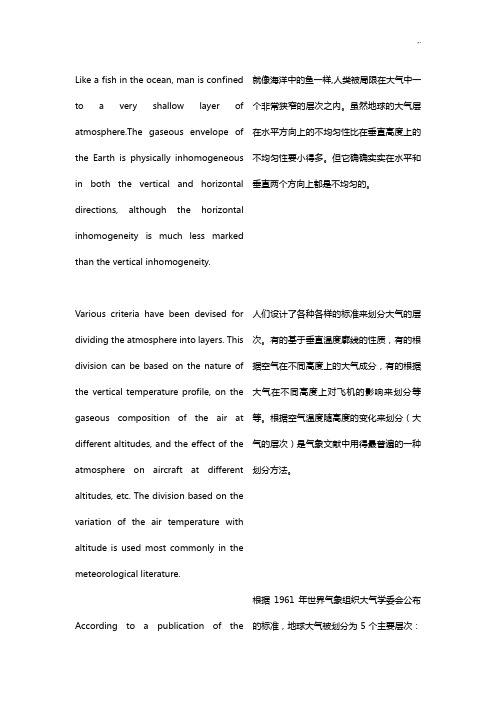
Like a fish in the ocean, man is confined to a very shallow layer of atmosphere.The gaseous envelope of the Earth is physically inhomogeneous in both the vertical and horizontal directions, although the horizontal inhomogeneity is much less marked than the vertical inhomogeneity.Various criteria have been devised for dividing the atmosphere into layers. This division can be based on the nature of the vertical temperature profile, on the gaseous composition of the air at different altitudes, and the effect of the atmosphere on aircraft at different altitudes, etc. The division based on the variation of the air temperature with altitude is used most commonly in the meteorological literature.According to a publication of the 就像海洋中的鱼一样,人类被局限在大气中一个非常狭窄的层次之内。
虽然地球的大气层在水平方向上的不均匀性比在垂直高度上的不均匀性要小得多。
但它确确实实在水平和垂直两个方向上都是不均匀的。
THMT-JPC-DL-Turbulence-les
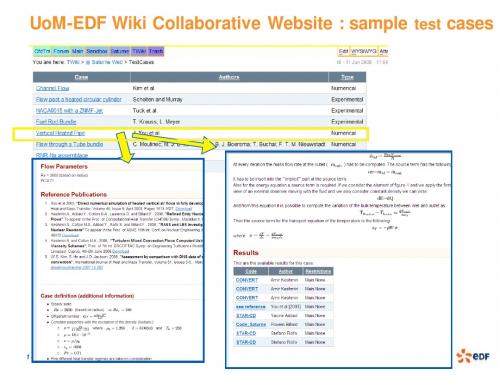
Models
6 - THMT 6, 2009 - H&FF Simulations for energies
Models
7 - THMT 6, 2009 - H&FF Simulations for energies
Models
8 - THMT 6, 2009 - H&FF Simulations for energies
In-line tube bundle
- Fully symmetric conditions, but non-symmetric solutions - Coanda effect ? - Star-CCM LES launched to confirm EDF finding
(Benhamadouche et al. NURETH 11, Avignon 2005)
L1 1 x , t
R1 1
R e r , x, t dr 0, x , t
0
18 - THMT 6, 2009 - H&FF Simulations for energies
Integral length scales in channel flow
Turbulent energy scale is easy RANS “model” but does not represent true (2 point correlation) integral scale for channel flow
Jet =>
Annular co-flow
Hand made grid very boring ! Need for tools for adaptive meshing
气象科技英语翻译【范本模板】
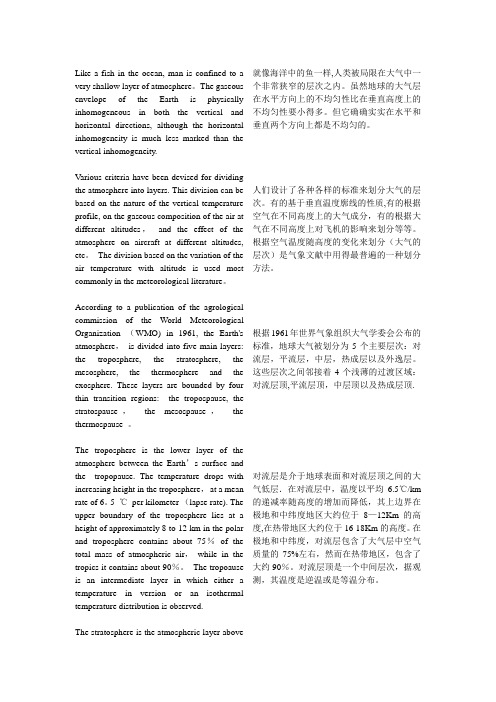
Like a fish in the ocean, man is confined to a very shallow layer of atmosphere。
The gaseous envelope of the Earth is physically inhomogeneous in both the vertical and horizontal directions, although the horizontal inhomogeneity is much less marked than the vertical inhomogeneity.Various criteria have been devised for dividing the atmosphere into layers. This division can be based on the nature of the vertical temperature profile, on the gaseous composition of the air at different altitudes,and the effect of the atmosphere on aircraft at different altitudes, etc。
The division based on the variation of the air temperature with altitude is used most commonly in the meteorological literature。
According to a publication of the agrological commission of the World Meteorological Organization (WMO) in 1961, the Earth's atmosphere,is divided into five main layers: the troposphere, the stratosphere, the mesosphere, the thermosphere and the exosphere. These layers are bounded by four thin transition regions: the tropospause, the stratospause,the mesospause,the thermospause 。
雷诺系数的公式
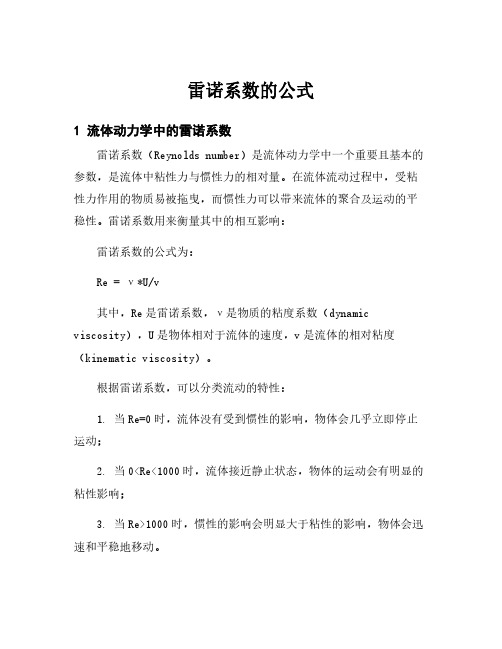
雷诺系数的公式
1流体动力学中的雷诺系数
雷诺系数(Reynolds number)是流体动力学中一个重要且基本的参数,是流体中粘性力与惯性力的相对量。
在流体流动过程中,受粘性力作用的物质易被拖曳,而惯性力可以带来流体的聚合及运动的平稳性。
雷诺系数用来衡量其中的相互影响:
雷诺系数的公式为:
Re=ν*U/v
其中,Re是雷诺系数,ν是物质的粘度系数(dynamic viscosity),U是物体相对于流体的速度,v是流体的相对粘度(kinematic viscosity)。
根据雷诺系数,可以分类流动的特性:
1.当Re=0时,流体没有受到惯性的影响,物体会几乎立即停止运动;
2.当0<Re<1000时,流体接近静止状态,物体的运动会有明显的粘性影响;
3.当Re>1000时,惯性的影响会明显大于粘性的影响,物体会迅速和平稳地移动。
因此,雷诺系数可以用来衡量流体中粘性力和惯性力的相对量,其大小对流体流动有很重要的影响,常常被用于研究和预报流体流动以及传热现象等。
- 1、下载文档前请自行甄别文档内容的完整性,平台不提供额外的编辑、内容补充、找答案等附加服务。
- 2、"仅部分预览"的文档,不可在线预览部分如存在完整性等问题,可反馈申请退款(可完整预览的文档不适用该条件!)。
- 3、如文档侵犯您的权益,请联系客服反馈,我们会尽快为您处理(人工客服工作时间:9:00-18:30)。
National Aeronautics and Space Administration Langley Research Center Hampton, Virginia 23681-2199 Prepared for Langley Research Center under Contract NAS1-97046
NASA/CR-2001-210860 ICASE Report No. 2001-10
Effects of Eddy Viscosity on Time Correlations in Large Eddy Simulation
Guowei He ICASE, Hampton, Virginia R. Rubinstein NASA Langley Research Center, Hampton, Virginia Lian-Ping Wang University of Delaware, Newark, Delaware ICASE NASA Langley Research Center Hampton, Virginia Operated by Universities Space Research Association
where uk; t is a Fourier mode of the velocity eld at the wavenumber vector k with k = jkj. The bracket h i" means ensemble averaging. The Eulerian time correlation measures the temporal changes seen by an observer in a xed reference frame with zero mean velocity. For a possible equilibrium range at high frequencies, such an observer sees small scale eddies being swept past him by larger scale eddies. The correlation coe cient 8, 9 between the LES and DNS elds has been used to evaluate the ability of LES to predict ow evolution. It was demonstrated that the correlation coe cient will decay to zero after a few eddy turnover times. This implies the LES and DNS elds will be completely decorrelated. However, this result is not discouraging. In fact, two DNS elds which are initially identical at large scales but slight di erent at small scales will also become completely decorrelated, although their uncoupled statistics still remain equal. Even independent random elds can be statistically identical. Therefore, the relevant question to ask is if the LES elds can reproduce the statistics of the DNS elds, whether the LES and DNS elds are correlated or not. In this paper, the validity of the LES is evaluated by its ability to reproduce the Eulerian time correlations of the DNS eld. Current SGS models can be categorized into several groups: eddy viscosity, stochastic, similarity, assumed SGS velocity models 5 and multiscale model 10 . The most extensively used SGS model is based on the eddy-viscosity assumption: the e ects of subgrid scale motion is supposed to be similar to that of molecular dissipation, but with an eddy viscosity which depends on both wavenumber and the cuto . Many eddy viscosity models have been developed including the Smagorinsky model, the kinetic-energy model and the dynamical model. In isotropic homogeneous turbulence, the eddy viscosity can be formulated in terms of the energy balance equation: 1.2
ICASE,
Key words. eddy viscosity, time correlation, large eddy simulation Subject classi cation. Fluid Mechanics 1. Introduction. In large eddy simulation of turbulent ows, large-scale velocity
Abstract. Subgrid-scale SGS models for large eddy simulation LES have generally been evaluated by
elds are computed directly from the ltered Navier-Stokes N-S equation, while the e ects of small-scale velocity elds on large-scale velocity elds are modeled using a SGS model. The SGS models are constructed to represent energy drain from large scales to small scales, and local inverse energy transfer, i.e., energy backscatter from small scales to large scales. It is desirable that the SGS models can produce a LES eld which correctly predicts the large-scale statistics of the N-S eld. A direct evaluation 1, 2, 3 of the SGS models is to compare statistics of the LES elds with those of the ltered N-S elds. There has been extensive work comparing single-time statistics of the LES and DNS elds. For recent reviews, see 4, 5 . However, there is little work concerning two-time statistics. This paper investigates the e ects of the eddy viscosity SGS models on the time correlations of the LES elds. The research is motivated by use of LES in the aeroacoustics 4, 6 , where sound radiation is dependent on Eulerian time correlations. Time correlations are among the simplest statistical properties of turbulent ow. We will consider Eulerian time correlations in isotropic homogeneous turbulence, whose Fourier transformation is expressed aCTS OF EDDY VISCOSITY ON TIME CORRELATIONS IN LARGE EDDY SIMULATION
GUOWEI HE , R. RUBINSTEINy , AND LIAN-PING WANGz
their ability to predict single-time statistics of turbulent ows such as kinetic energy and Reynolds stresses. Recent applications of large eddy simulation to the evaluation of sound sources in turbulent ows, a problem in which time correlations determine the frequency distribution of acoustic radiation, suggest that subgrid models should also be evaluated by their ability to predict time correlations in turbulent ows. This paper compares the two-point, two-time Eulerian velocity correlation evaluated from direct numerical simulation DNS with that evaluated from LES, using a spectral eddy viscosity, for isotropic homogeneous turbulence. It is found that the LES elds are too coherent, in the sense that their time correlations decay more slowly than the corresponding time correlations in the DNS elds. This observation is con rmed by theoretical estimates of time correlations using the Taylor expansion technique. The reason for the slower decay is that the eddy viscosity does not include the random backscatter, which decorrelates uid motion at large scales. An e ective eddy viscosity associated with time correlations is formulated, to which the eddy viscosity associated with energy transfer is a leading order approximation.
